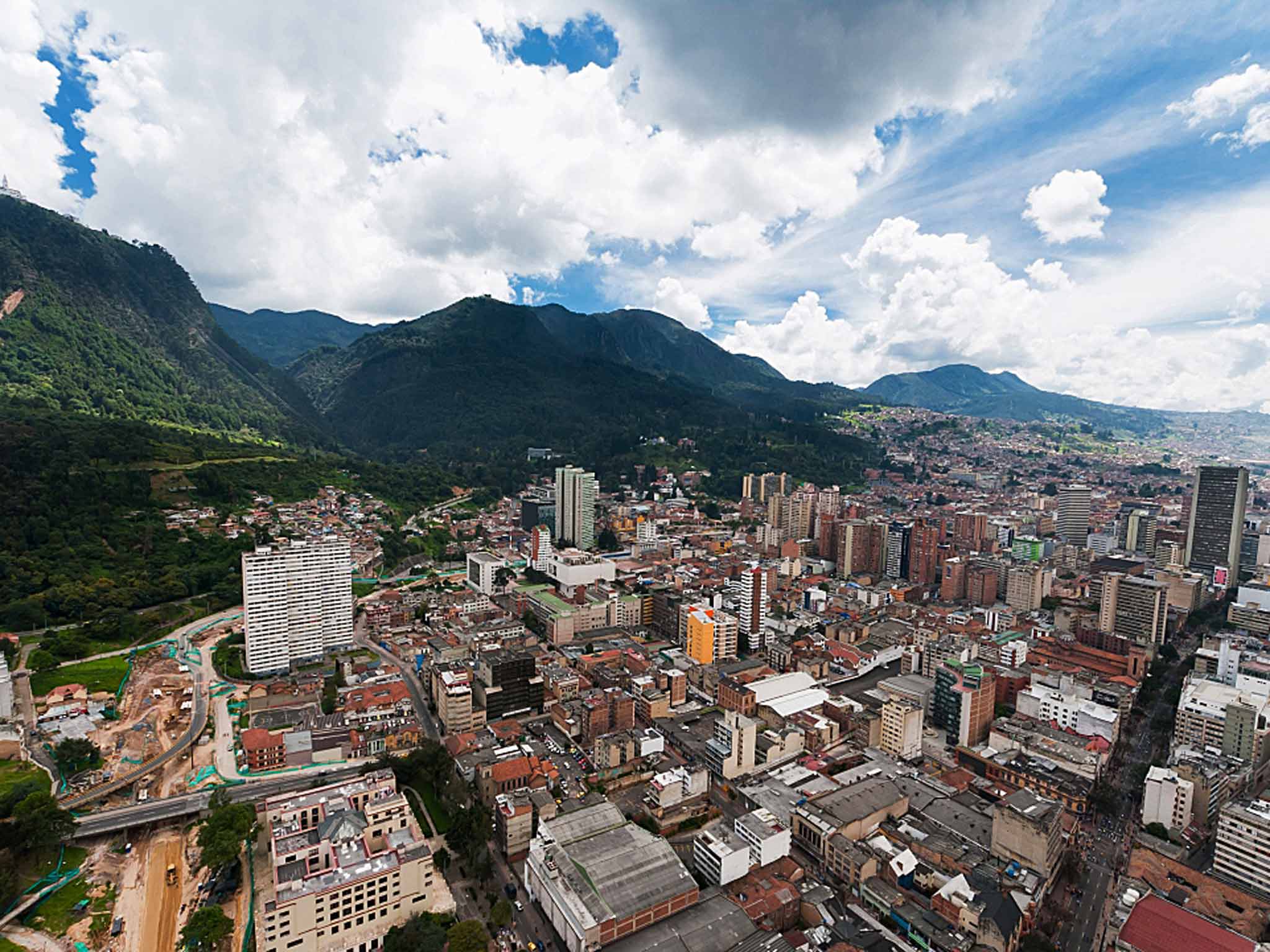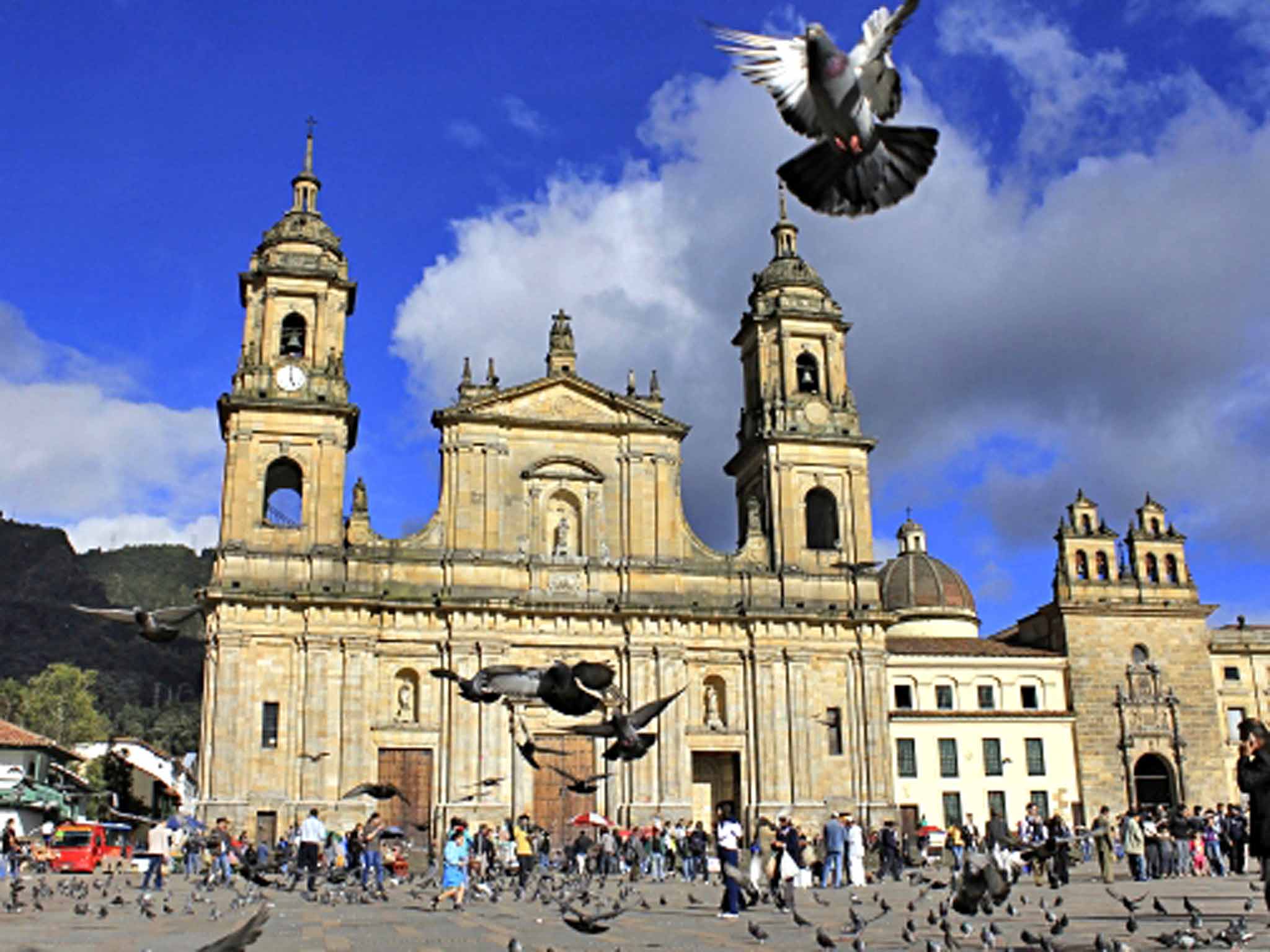The Independent's journalism is supported by our readers. When you purchase through links on our site, we may earn commission.
Bogota travel tips: Where to go and what to see in 48 hours
Colombia's capital is much more than just a gateway to South America, says Chris Leadbeater

Travel essentials
Why go now?
After a gap of 10 years, Colombia is back on the traveller's radar thanks to the restoration of direct flights from the UK. Avianca (0800 031 4206; avianca.com), flies to Bogota four times a week from Heathrow, with connections to destinations across the continent. It's well worth building in a stopover in this beautiful and surprising city.
Touch down
El Dorado airport (00 57 1 266 2000; eldorado.aero) sits nine miles west of the centre. Avianca has the only non-stop flights from Britain; for other UK departure points and/or lower fares, the main choices are Air France via Paris, Lufthansa via Frankfurt and Iberia via Madrid; US carriers have many routes, but these require you to clear American immigration.
Official airport taxis (yellow and white) are the quickest onward option, taking around 20 minutes to the centre, and costing from 15,000 Colombian pesos (£4.50), depending on traffic. Line K of the TransMilenio bus service (00 57 1 220 3000; transmilenio.gov.co) starts at the airport, ending 40 minutes later at the Universidades (1) stop, at the junction of Carrera 3 and Calle 20. Singles cost from C$1,400 (42p) across the whole network.
Get your bearings
Bogota lies at the heart of Colombia – at the foot of Monserrate (2), an Andean bluff which rears up to the east. The city's layout is a sprawling grid, with numbered carreras and calles running north to south and east to west respectively. Numbers are lowest in the centre, rising as the conurbation fans out. The smallest street numbers are found in La Candelaria, the city's colonial core and main tourist zone. La Macarena, to the north, is known for its restaurants – while the "new" district of Chapinero, further north, also offers refined eateries and busy bars.
The centre can be seen on foot, but the 12 TransMilenio lines – essentially trams minus tracks – make wider exploration feasible. The key tourist office (3) is in the Palacio Lievano on Plaza de Bolivar 00 57 1 283 7115; bogotaturismo.gov.co), open daily 8am-6pm (10am-4pm Sundays). See colombia.travel and lata.org.
Click here to see a bigger image of the map
Check in
La Candelaria is the accommodation motherlode. Abadia Colonial (4) (00 57 1 341 1884; abadiacolonial.com) is a little boutique retreat with a veranda overlooking the street at 2-32 Calle 11 – doubles from C$180,000 (£54), with breakfast.
Hotel de la Opera (5), at 5-72 Calle 10 (00 57 1 336 2066; hotelopera.com.co), mixes restored colonial charm with a modern spa – doubles from US$200 (£123), with breakfast.
And The Orchids Hotel (6) shines at 10-55 Carrera 5 (00 57 1 745 5438; theorchidshotel.com). Its suites go by such names as "Tristan und Isolde", and have butler service (from C$550,000/ £165, with breakfast).
Day one
Take a hike
Plaza de Bolivar (7) is a jaunt in itself – the point where Bogota was founded by the conquistador Gonzalo Jiménez de Quesada in 1538. Start on its north side at the Palacio de Justicia (8), Colombia's stern supreme court, which was built in 1989 after its predecessor was destroyed in a 1985 battle between the army and rebels. Continue to the west of the square, where the Palacio Lievano (3), city hall, is almost Parisian in its pretty façade. On the south edge, the Capitolio Nacional (9), Colombia's houses of congress, is a Neoclassical joy – finished in 1926 after a tortuous process that began in 1876. End on the square's east side at the Catedral Primada (10), a 19th-century Catholic bastion where Quesada is buried (9am-5pm daily; 00 57 1 341 1954; catedraldebogota.org).
Window shopping
Pasaje Rivas (11), in La Candelaria at Carrera 10 and Calle 10, is a pleasingly untacky craft market with local art and jewellery. Reasonably nearby at 4-35 Avenida Jimenez, Libreria Lerner (12) is a superb bookshop filled with weighty tomes, maps, guidebooks and browsing customers (00 57 1 334 7826; librerialerner.com.co).
Mercado de Paloquemao (13), north-west of the centre at Calle 19 and Carrera 27 (00 57 1 742 6664; plazadepaloquemao.com), is a crucial part of Bogota's soul – a market awash with fresh fruit, bright blooms, thick chunks of meat and seafood (open daily 8am-1pm).
Lunch on the run
Dip into La Macarena, where La Casa de la Abuela (14), at 4-75 Calle 27 (00 57 1 243 0831), is famed for its ajiaco (gloopy chicken stew with potatoes) for C$8,500 (£2.50).
Cultural afternoon
A lust for gold brought the Spanish to Colombia and some of the objects of their obsession are displayed at the Museo del Oro (15), at 15-88 Carrera 6 (00 57 1 343 2222; bit.ly/GoldMus; daily 9am-6pm except Sunday, 10am-4pm, and Monday, closed; C$3,000/90p).
You'll find glittering trinkets created by such pre-conquest indigenous groups as the Muisca, Tolima, Calima and Tairona. Exhibits include intricate carved jaguar faces and a golden Muisca ceremonial raft.
The Museo Botero (16) (00 57 1 343 1316; bit.ly/BotMus; daily 9am-7pm except Sunday, 10am-5pm; free), at 4-41 Calle 11, displays pieces – plump sculptures; exaggerated human figures – by Fernando Botero, Colombia's greatest living artist.
The Museo de Arte Moderno (17) (00 57 1 286 0466; mambogota.com; daily 10am-6pm, except Sunday 12-4.30pm, and Monday, closed; C$4000/£1.20), at 6-00 Calle 24, covers such major figures of Colombian art as Alejandro Obregon, Enrique Grau and Edgar Negret.
An aperitif
Pop into Quiebra Canto (18) at 17-76 Carrera 5 (00 57 1 243 1630; quiebracanto.com), a popular bar-club which does live salsa at weekends, and bottled beer for C$5,000 (£1.50).
Dining with the locals
El Son de los Grillos (19) (00 57 284 8662) revels in a colonial vibe at 3-60 Calle 10 in La Candelaria, serving chicken with peppers and salsa for C$21,900 (£6.50). Donostia (20) is a chic option at 5-84 Calle 29 in La Macarena (00 57 1 287 3943; elorigendelacomida.co), with barbecued pork ribs for C$30,000 (£9). Harry's Restaurant (21) (00 57 1 321 3940; harrysasson.com) – run by Bogota star chef Harry Sasson at 5-57 Calle 70 in Chapinero – proffers Argentinian sirloins for C$37,000 (£11).

Day two
Sunday morning: go to church
The cathedral (10) may have the prime location, but the Iglesia de San Francisco (22) has the looks. Bogota's oldest church is a mighty landmark, constructed with missionary zeal between 1550 and 1567 (00 57 1 341 2357; templodesanfrancisco.com).
It stands at Carrera 7 and Avenida Jiménez, happily out of kilter with the modern office blocks around it. Its double doors open on to a gloomy interior of dark wood, gold leaf and incense aromas giving the appearance of the 16th century trapped in the 21st. It opens 8am-1pm and 4.30-7pm on Sundays; 6.30am-8pm on other days (closed 12.40-4pm on Saturdays).
Out to brunch
Stop off at La Puerta Falsa (23), a fast-food institution at 6-50 Calle 11 in La Candelaria (00 57 1 286 5091). Here, tamales (doughy parcels stuffed with meat or cheese) are doled out (from C$3,500/£1) to an endless queue of hungry diners, in a house that dates back to 1816 .
Take a ride
Monserrate (2) dominates Bogota's skyline. There are two easy ways to reach its summit – a funicular railway and a teléferico (cable car). Both depart from a base station (24) at Carrera 1 and the Circunvalar avenue, with single tickets for either from C$4,700 (£1.40) (returns C$9400/£2.80).

A walk in the park
Those with the energy can walk up Monserrate (2) on a trail that begins alongside the base station (24). The path can be steep – deliberately so because the Santuario de Monserrate (25) at its peak has been a site of pilgrimage since the mid-1600s (00 57 1 283 1643; santuariomonserrate.org). It is a basilica where El Senor Caido de Monserrate – a gory Christ statue – is the rather unnerving main draw.
Of broader appeal is the view back across Bogota. Monserrate reaches a height of over 10,000 feet, and gives a fine snapshot of this city of seven million inhabitants.
The icing on the cake
If the café or restaurant at Casa Santa Clara (26) (00 57 1 281 9309; restaurantecasasantaclara.com) is open, you may care to dine at altitude. Otherwise drop back into La Candelaria and head for the Teatro Colon (27) at 5-32 Calle 10 (00 57 1 381 6380; teatrocolon.gov.co). Bogota's celebrated 1892 theatre will soon stage a four-night run (6-9 November) of Black El Payaso, an operetta whose tale of civil war has echoes here.
Join our commenting forum
Join thought-provoking conversations, follow other Independent readers and see their replies
Comments
Bookmark popover
Removed from bookmarks